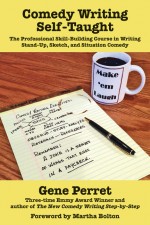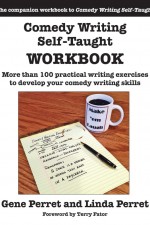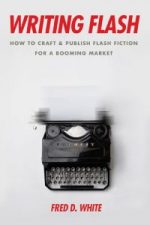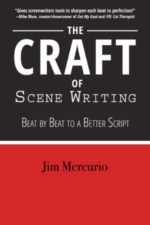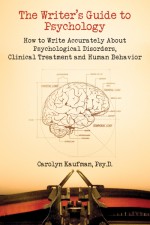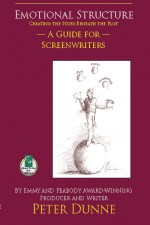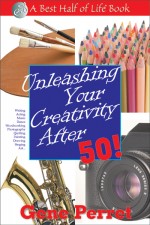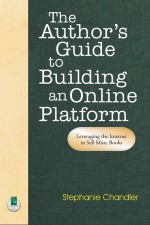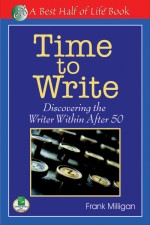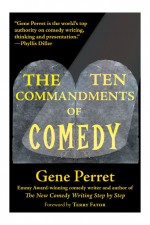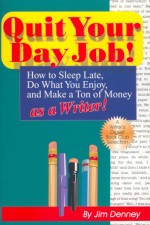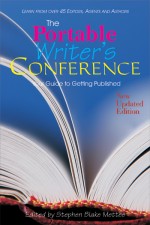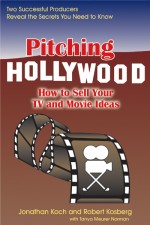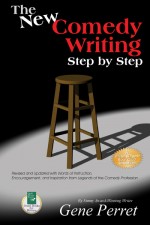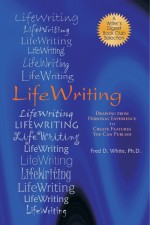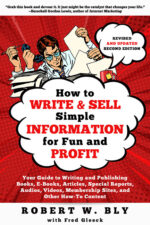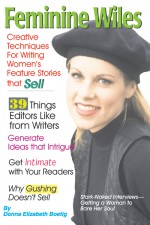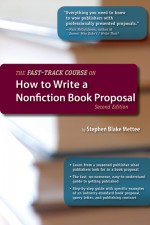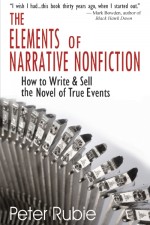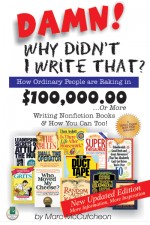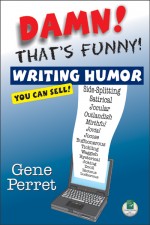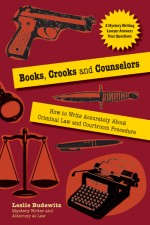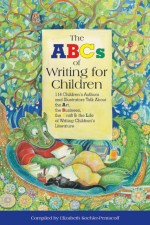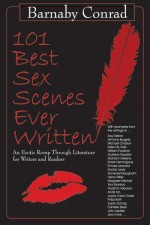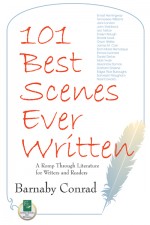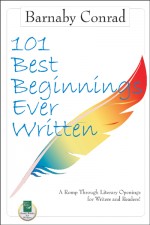Fiction
- Fantasy (1)
- Horror (1)
- Legal Thriller (3)
- Mystery (8)
- Science Fiction (2)
- Suspense (2)
List Grid
“Family, friends and society are the natural enemies of the writer. He must be alone, uninterrupted and slightly savage if he is to sustain and complete an undertaking.”
The Professional Skill-Building Course in Writing Stand-Up, Sketch, and Situation Comedy
by Gene Perret
Publication Date: January 15, 2015 $16.95 ($17.95 Canada) • Trade Paperback • 6″ x 9″ • 170 pages ISBN 978-1-61035-220-8 To the beginner, writing effective comedy can seem like a mysterious knack you need to be born with. But to Emmy award–winning comedy writer Gene Perret, comedy writing is a set of skills that anyone can study, improve, and master.
In Comedy Writing Self-Taught, Perret (a three-time Emmy winner and former head writer for Bob Hope and Phyllis Diller) teaches aspiring comedy writers how they can teach themselves the essential principles of comedy writing through comedy analysis and writing exercises. Covering the essential principles of writing stand-up comedy, sketch comedy, and TV situation comedy, Comedy Writing Self-Taught is professional-level training from a master who has spent decades at the very top of the entertainment industry.
Expressly designed for home self-study, Comedy Writing Self-Taught teaches that the most effective way to learn is to create comedy yourself. Perret teaches how to analyze the work of professional comedians to learn the principles of comedy and presents a full set of writing exercises to hone one’s skills.
The companion Comedy Writing Self-Taught Workbook provides even more comedy writing exercises, giving readers the equivalent of a master class in comedy. Comedy Writing Self-Taught also gives readers valuable advice from an experienced professional on how to pitch one’s work, break into the business and get paid for writing comedy.
Combining expert knowledge, rigorous training, shrewd observations about the nature of the entertainment busi- ness and hilarious jokes, Comedy Writing Self-Taught is a must-read book for every aspiring comedy writer and comedian.
ALSO AVAILABLE: Comedy Writing Self-Taught Workbook
About the Author: Gene Perret has written comedy material for such legendary performers as Bob Hope, Phyllis Diller, Carol Burnett, Tim Conway and others. He has been awarded three Emmys and one Writer’s Guild Award for his work on The Carol Burnett Show writing staff. He is the author of over 40 books, including the classic The New Comedy Writing Step-by-Step, available from Quill Driver Books.
The Professional Skill-Building Course in Writing Stand-Up, Sketch, and Situation Comedy
by Gene Perret
The WORKBOOK is the companion volume to Comedy Writing Self-Taught.
How to Craft and Publish Flash Fiction for a Booming Market
by Fred D. White
Writing Flash is a fast and informative guide for writers who want to develop their skills in one of fiction’s most challenging genres. Acclaimed creative writing teacher Fred D. White gives a fast-paced and in-depth introduction to the fascinating genre of flash fiction, the art of the ultra-short story that is 1,000 words or fewer.
White shows that mastering flash fiction is an indispensable skill-building challenge for any writer. Learning how to compress a story to its most essential elements will make your writing vigorous, evocative and full of emotion — invaluable skills for any kind of writing, including writing novels and longer short fiction.
Writing Flash presents a comprehensive introductory course to the techniques of flash fiction, beginning with a rigorous analysis of the mechanics of effective flash stories that will give you new insights into the bones and sinews of all literature. Each chapter also contains challenging exercises that will strengthen specific writing skills, extend your abilities and give valuable practice in the craft of flash fiction.
But flash fiction is more than just an exercise. It’s also an elegant art in its own right that can produce stories of startling depth and feeling. White illustrates flash fiction techniques and strategies by giving numerous examples of some of the best flash stories from great writers.
Writing Flash also includes fantastic resources for aspiring flash writers, including tips on publishing and marketing your own flash fiction to build your writing career, plus extensive lists of flash fiction literary journals, award contests and resources for further study.
Writing Flash won’t just help you become a better flash fiction writer; this book will help you become a better writer, period.
Audience: Professional and aspiring creative writers.
About the Author: Fred D. White received his Ph.D. in English from the University of Iowa. For nearly 40 years White has taught writing courses at Santa Clara University, where he is now Professor of English, Emeritus. White has published several books on writing, as well as dozens of stories, essays, poems and plays.
$14.95 US • Trade Paperback • 6″ x 9″ • 150 pages
ISBN 978-1-61035-317-5
Creative Writing • LAN005000
Bibliography • Index
Beat by Beat to a Better Script
by Jim Mercurio
No one comes out of a movie talking about script structure. What audiences love and remember about a movie are great scenes, the meaningful moments in a film that reveal character and emotion.
While previous screenwriting guides emphasize story structure at the macro level, The Craft of Scene Writing: Beat by Beat to a Better Script is the first book for screenwriters that focuses entirely on the micro level of writing powerful scenes. Story structure alone does not make a successful screenplay; it is the detailed craftwork of scene writing that breathes life into a story.
In The Craft of Scene Writing, accomplished screenwriter and master writing teacher Jim Mercurio explains the nuts and bolts of how to write emotionally resonant scenes that will elevate a script from ho-hum to extraordinary.
The Craft of Scene Writing analyzes and systematizes the individual elements that create dynamic scenes: beats, conflicts, character moments, specific actions and lines of dialogue. Mercurio demonstrates that every single scene in a script needs to be a story in itself that creates a surprise or reversal. And when a scene incorporates both a twist in the plot and a change in the characters’ internal states, it has the greatest potential to profoundly engage an audience.
The Craft of Scene Writing cites specific examples from popular classic scripts, old and new, to show how great scenes reveal character and advance the story. The Craft of Scene Writing also gives readers practical tools to immediately improve their scenes and scripts.
Writing amazing scenes won’t just make a screenplay a better work of art. Great scenes also make a script more attractive to producers, directors and actors — making a script more likely to sell.
An incredibly detailed exploration of screenwriting technique, The Craft of Scene Writing will help beginning writers to write great scripts and experienced writers to gain a more complete mastery of their craft.
Audience: Professional and aspiring screenwriters, playwrights, fiction writers and other creative storytellers.
About the Author: Jim Mercurio is a writer, author, screenwriter and filmmaker. He has directed or produced five feature films and has helped countless writers as a teacher, story analyst and script doctor. Creative Screenwriting magazine ranked him as one of the top screenplay consultants in the country.
$18.95 US • Trade Paperback • 6″ x 9″ • 400 pages • Index
ISBN 978-1-61035-330-4
subtitle: “How to Write Accurately about Psychological Disorders, Clinical Treatment and Human Behavior”.
Writers frequently write about mental illness and psychological motivations, but all too often they use terms and concepts that are clichéd, outmoded or just plain wrong.
Written by a clinical psychologist who is also a professional writer and writing coach, The Writer’s Guide to Psychology is an authoritative, accessible, fun, and easy-to-use reference to psychological disorders, diagnosis, treatments, psychotherapists’ work and what really makes psychopathic villains tick.
The only reference book on clinical and counseling psychology designed specifically for the needs of writers, The Writer’s Guide to Psychology presents specific writing dos and don’ts to avoid the psychobabble clichés and misunderstandings frequently seen in popular writing. The book’s extensive sidebars include Q&As from real writers, information on controversial treatments and issues, tips for using realistic psychology to create complex and compelling characters, and Don’t Let This Happen to You! boxes that humorously expose mortifying mistakes in fiction, film and TV … and teach readers how to get it right in their own writing.
The leap from concept to final draft is great, and the task is filled with hard work and horrors. It is here that most writers struggle to get the plot right at the expense of the story’s real power. The result is a script that is logical in every way, yet
unmoving.
Emotional Structure, by Emmy- and Peabody-Award winning producer, writer, and teacher, Peter Dunne, is for these times, when the plot fits nicely into place like pieces in a puzzle, yet an elemental, terribly important something remains missing.
The missing piece won’t be found by adding action, you can’t stir the soul with a car chase. And the problem won’t be helped by a change of location, the only location that matters is deep in your protagonist.
The solution is to pay constant attention to the inseparable nature of plot development and emotional development.
When you create any scene, whether it’s a police pursuit on the interstate or a heart-to-heart in the kitchen, the emotional reasoning behind the scene has to be evident. When you develop the emotional current that sustains the action, you create a scene with heart and soul, and you-and your viewers-are going to feel the passion.
Scene after scene, Dunne (Sybil, Dallas, Melrose Place, CSI, Jag, Dr. Quinn: Medicine Woman) shows you how to develop the dramatic equilibrium of incident and response, of intellect and emotion that will turn your screenplay’s problems into its power.
The buzz word in publishing houses and at writer’s conferences these days is platform. As in, “What is the author’s platform?”
With more than 175,000 new titles published each year, publishers want to sign authors who are capable of helping to sell their book. The platform may be that the author is a widely syndicated columnist, is the internationally acclaimed expert in his field, or is a highly sought-after motivational speaker. Or perhaps the author is a New York City television news anchor. These types of platforms make a publisher’s mouth water.
But what about authors who aren’t widely known or acclaimed? How does the ordinary guy build a credible platform?
The answer: the Internet. Today you can build an international platform right from your kitchen table—even if your kitchen table is in Manhattan…Kansas.
By Gene Perret
Beginning comedy writers and performers think you can’t teach funny. Legendary comedy writer Gene Perret, winner of three Emmy Awards, knows better. A good joke works because it follows ten strict principles — or, as Perret calls them, The Ten Commandments of Comedy. Perret calls these principles “Commandments” for good reason — these rules strengthen your material and make every joke as funny as it can possibly be. Violating even one or two of these precepts might destroy an otherwise viable gag. But a joke that follows all the Commandments will deliver maximum humor … and audiences know the difference.
Three-time Emmy Award-winner Gene Perret’s Comedy Writing Step by Step has been the manual for humor writers for 25 years. In this new book, his first update, Perret offers readers a treasure trove of guidelines and suggestions covering a broad range of comedy writing situations, along with many all-important insights into the selling of one’s work. Perret covers all aspects of comedy writing in his uniquely knowledgeable and anecdotal fashion.
A complete review of the modern publishing process, this resource is an ideal companion for aspiring authors who want to understand and break into this ever-changing industry.
Featuring advice from a robust roster of literary agents, editors, authors, and insiders-including Random House Editor at Large David Ebershoff, literary agent and former Book of the Month Club Editor in Chief Victoria Skurnick, and New York Times-bestselling author Bob Mayer-this guidebook demystifies the entire publishing process and offers some hints on where the publishing industry is headed.
Thorough discussions on the difference between fiction and nonfiction publishing, working with an agent, maximizing marketing and promotional opportunities, and getting published in magazines, newspapers, and online make this an essential reference for anyone wanting to plot a course for publishing success.
Lifewriting is people-centered nonfiction writing. Not just autobiographical or biographical, lifewriting encompasses a broad range of personal-experience narratives. Lifewriting can be serious or humorous or both. It can include any kind of subject matter because people are always at the heart of any endeavor. Fred D. White Ph.D., author of four textbooks on writing, walks the reader through the process from research to composition to revision to marketing.
Using the knowledge inherent in writing more than 90 works of fiction including Logan’s Run—soon to be a major Warner Bros. movie—William F. Nolan uses a brisk and humorous style to teach the reader how to craft novels and short stories that sell.
Please note: We accept PayPal only on the website. For credit card orders, please call us at 800-345-4447. Thank you!
Revised and Updated Second Edition
by Robert W. Bly
Publication Date: October 26, 2021
The definitive guide to making real money as a writer—revised and updated for the online media market of the 2020s!
Do you love educating others? Do you want to make money doing it? The world of how-to writing is waiting for you! In How to Write and Sell Simple Information for Fun and Profit, copywriting legend and self-made millionaire Robert W. Bly shares his secrets to how any motivated person can turn simple information into a six-figure income.
Bob Bly spells out how you can find your writing niche, develop ideas for salable how-to books, ebooks, articles, video, audio content and more; repackage content in a dizzying variety of proven-to-sell products; promote and market your work; and earn $100,000 a year or more.
This revised and updated second edition of How to Write and Sell Simple Information for Fun and Profit adapts Bly’s tried-and-true formulas for writing success to the modern online content market, including best practices for monetizing podcasts, YouTube channels, webinars, Facebook groups, social media, software, and more.
You don’t have to be the world’s greatest writer. You don’t have to be the leading guru in your field. But if you have a curious mind and love learning new things, you can be a six-figure success as a how-to writer—and How to Write and Sell Simple Information for Fun and Profit will show you how!
$18.95 US • Trade Paperback • 6″ x 9″ • 326 pages
ISBN 978-1-61035-990-0
Pick up the Sunday paper and consider how many stories it takes to fill all those pages. How can any newspaper staff produce so many stories every day, every week, every month of the year and keep up with breaking news, too?
They can
How to see your name as a contributing writer for the glossy women’s magazine market.
A step-by-step guide through the process of proposing a book to a publisher, this straightforward and accessible work helps aspiring authors get their nonfiction work published quickly. Packed with specific examples of proposals, query letters, publishing contracts, and more, this reference addresses the many questions authors have in this digital age. Written by a seasoned editor and used in publishing classes at numerous universities, the book is a proven tool for nonfiction book authors. A glossary of key terms, a list of selected books for further reading, and a book proposal checklist are also included.
2nd edition.
Subtitle: 21 Steps to the Clear Prose Publishers and Agents Crave
Most writers toil their whole lives without ever getting published. The reason? Foggy writing — writing that’s full of unnecessary, misused, and overused words. Foggy writing drives editors crazy, and makes publishers and agents reject manuscripts at first glance. Veteran editor Don McNair lays out an easy-to-follow, systematic method for clearing up foggy writing and producing sparkling copy that attracts readers, agents, editors, and sales in his new book Editor-Proof Your Writing: 21 Steps to the Clear Prose Publishers and Agents Crave.
In his more than 40 years as a professional editor and writing instructor, McNair found that most writers make the same mistakes over and over again, and nearly all of these mistakes can be corrected simply by removing specific words. In Editor-Proof Your Writing, McNair presents his classroom-proven, systematic method for rooting out foggy words and phrases, producing clear, vigorous and powerful prose.
In just 21 steps, Editor-Proof Your Writing teaches how to edit weak verb forms, strip away author intrusions, ban redundancies, eliminate meaningless phrases, correct passive-voice sentences, slash misused and overused words, and fix other writing mistakes.
Editor-Proof Your Writing doesn’t present theory; it shows how to apply knowledge. McNair asks readers to use the first chapter of their manuscripts as a practice text. Each chapter introduces a step to defog writing and then asks the reader to try it out on his or her own work.
A superb addition to any writer’s toolkit, Editor-Proof Your Writing won’t just make you a clearer and more grammatical writer; it will make you a better writer — more expressive, more entertaining and more likely to sell your work.
How Ordinary People are Raking in $100,000.00 or More Writing Nonfiction Books & How You Can Too!
In Damn! That’s Funny!, readers learn from a true pro what makes readers laugh, how to write humorous pieces, how to add humor to serious articles, and how to market their material. Written by television comedy writer Gene Perret, a three-time Emmy Award-winner and longtime head writer for Bob Hope.
Subtitle: “How to Write Accurately About Criminal Law and Courtroom Procedure”
Using examples from actual cases, as well as fiction, movies and television, Books, Crooks, and Counselors answers real writers’ questions on over 160 separate topics, including: criminal and civil law; differences between federal, state, and Native American jurisdiction; legal aspects of police and private investigation; criminal sentencing, including the death penalty; wills and inheritances; legal terminology; and the written and unwritten codes that govern the public and private conduct of lawyers and judges.
Winner of the 2011 Agatha Award for Best Non-Fiction Book of the Year.
2012 Anthony and Macavity Nominee for Best Non-Fiction Book of the Year.
Subtitle: 114 Children’s Authors and Illustrators Talk About the Art, the Business, the Craft and the Life of Writing Children’s Literature.
List Grid
 Updating…
Updating… 

